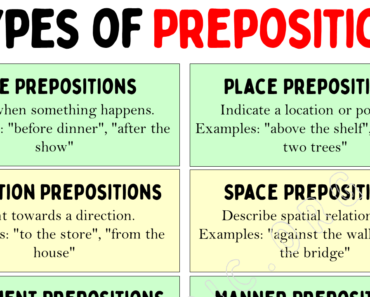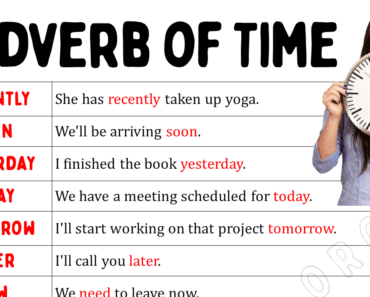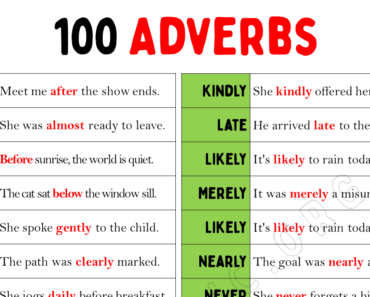In this useful lesson, we’re going to explore 15 types of adverbs that make English more fun and clear. Adverbs are like magic words that help us describe how, when, and where things happen. Imagine you’re adding special spices to make a dish taste better; that’s what adverbs do for our sentences! This is perfect for anyone starting to learn English or wanting to make their English even better. So, let’s explore and make our sentences sparkle with these adverb secrets!
Definition of Adverbs
An adverb is a verb that describes a verb, an adjective, or another adverb.
Example:
- She is very (Very is an Adverb)
- Unfortunately, he had an accident. (Unfortunately is an Adverb)
Position of Adverbs
We can put adverbs and adverb phrases at the front, in the middle, or at the end of a clause.
Examples:
- Suddenly, she fell down.
- She is always late for everything.
- Why do you eat so fast?
Types of Adverbs and Their Positions
Different types of adverbs go in different places.
- Adverbs of manner
- Adverb of time
- Adverb of place
- Adverb of frequency
- Adverb of degree/quality
- Adverb of certainty and obligation
- Adverb of affirmation
- Adverb of negation
- Interrogative adverbs
- Relative adverbs
- Adverb of probability and certainty
- Adverb of attitude
- Adverb of reason/purpose
- Adverb of duration or period
- Adverb of conjunction
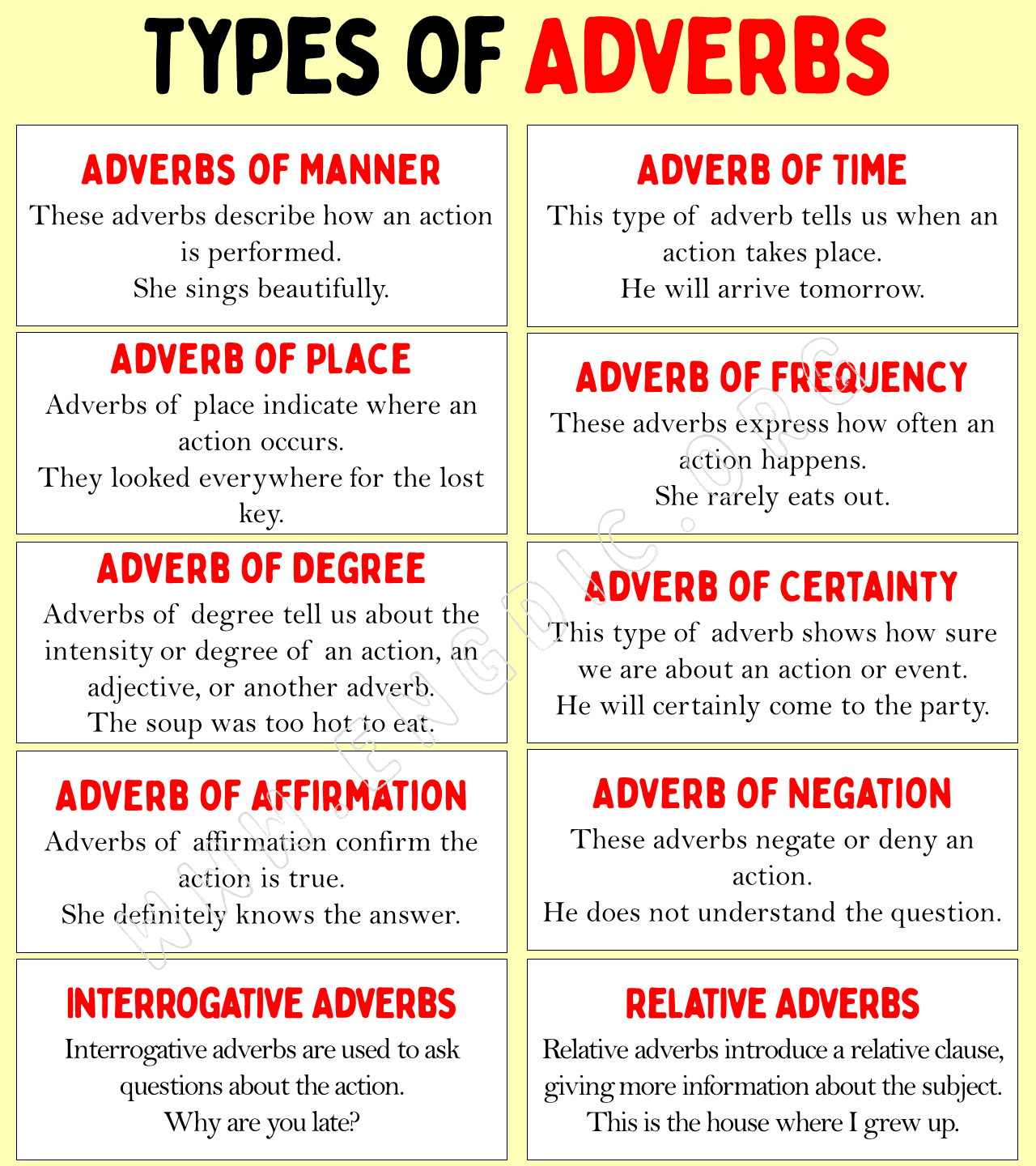
Adverbs of Manner
The adverb of manner tells us how something happens. They are usually placed after the main verb or after the object.
Examples:
- She walks
- She spokes
- He beats drum
Adverb of Place
The Adverb of Place tells us where something happens. Adverbs of place are like adverbs of manner. They come after the direct object or the verb.
Examples:
- He sat
- They build a house
Adverb of Time
The Adverb of time tells us when, how long, and how often an action happened.
Different adverbs of Time are given:
- When: Today, yesterday, later, now, last year
- For how long: all day, not long, for a while, since last year
- How often: sometimes, frequently, never, often, yearly
Adverb of Duration
They usually go in the end position.
Examples:
- I am not ill anymore.
- I left Multan
Adverb of Frequency
An adverb of frequency is also an adverb of time. It tells us how often an action takes place. It is usually placed before the main verb but after the auxiliary verbs (such as be, have, may, must, etc.)
Examples:
- I sometimes visit my uncle.
- We have often seen him studying till late at night.
- He is seldom
- Sometimes, they visit for free.
- I miss him
- I meet her very
- Ali eats meat very
Adverbs of Degree/Quality
Adverbs of Degree tell us about the intensity or degree of an action, an adjective or another adverb.
Some common adverbs of degree are:
Almost, near, quite, just, too, enough, hardly, scarily, completely, very, extremely.
Adverb of Certainty and Obligation
Some adverbs of certainty go in the mid position.
E.g.
Probably, possibly, certainly.
Examples:
- It will probably take about a week.
- I will certainly be obliged.
Adverb of Affirmation
Adverbs of affirmation declare that the given statement or the fact is true.
A few of such adverbs are:
Never, no, not, not by all, by no means, no longer, etc.
Interrogatives Adverbs
Interrogative Adverbs are used for asking questions. They are usually placed at the beginning of the sentence.
They include:
How, when, why, and where
Examples:
- When did he come?
- Where did she go?
- How are you doing?
- When did you do this?
Relative Adverbs
Relative adverbs are (where, when, and why). They introduce a relative clause. And then a relative clause is a sort of subordinate clause that functions as an adjective. It modifies a noun in the sentence.
Examples:
Read; the relative adverbs in the following examples are given in bold.
- He was born in the year when I left America.
- This is the place where we met last year.
- I have no idea why he called me a liar.
Adverb of Probability and Uncertainty
Adverbs of probability show how sure we are about an event or a situation.
The most common adverbs of probability are:
Definitely, certainly, clearly, obviously, possibly, perhaps, probably, maybe.
Examples:
- Perhaps he will help me.
- Maybe, it would not rain.
- He is certainly taking the exams this year.
- I will definitely pay the dues on time.
- He will possibly marry his cousin.
- She was obviously surprised by my proposal.
Adverbs of Attitude
The adverb of attitude expresses the writer’s attitude toward an issue stated in the sentence.
Some common adverbs of attitude are:
Fortunately, luckily, obviously, apparently, naturally, clearly, frankly, hopefully, really, surprisingly, unfortunately, unluckily, etc.
Adverb of Reason/Purpose
Adverbs of reason give the reason behind a particular happening.
Some common adverbs of reason are:
Hence, thus, therefore, because, so, since, accidentally, purposely, consequently, in order to, lest, etc.
Adverb of Duration or Period
Adverbs of duration tell us about the duration or period of some event or situation.
Some common adverbs of duration are:
Since, from, till next, for, last, still, yet, already, coming, no more, any more, long, no longer, any longer, briefly, forever, shortly, permanently, temporarily, etc.
Adverbs of Conjunction
Adverbs of Conjunction connect ideas or clauses. They show the relation between the two clauses.
Some common adverbs of Conjunction are:
Also, conversely, likewise, otherwise, consequently, indeed, still, therefore, subsequently, thus, accordingly, besides, finally, hence, instead, however, moreover, nevertheless, next, similarly, nonetheless, otherwise, then, furthermore, etc.
Infographics
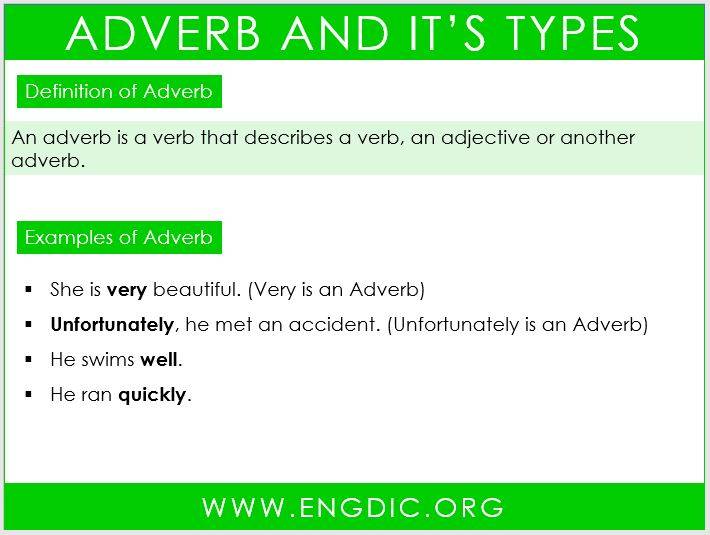

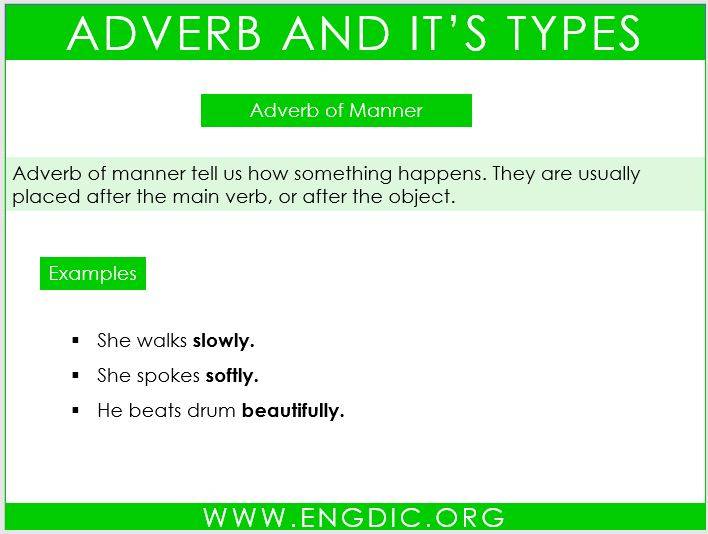
Download this lesson of “adverb and its types” in PDF here.


